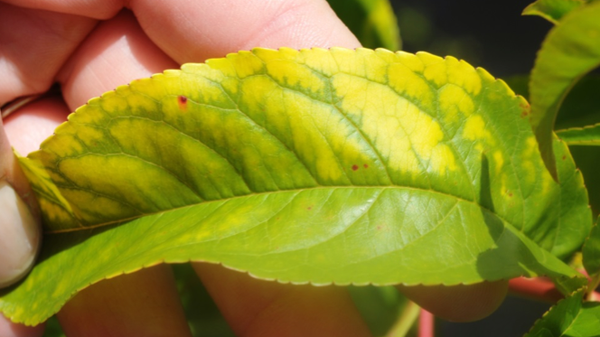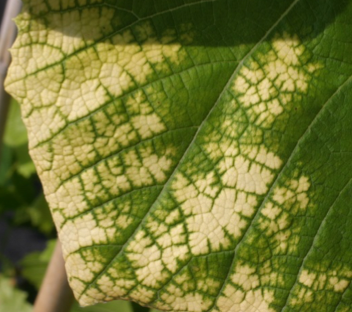Problem
Herbicide injury caused from photosystem II (PS II) inhibitors including s-triazines (such as atrazine and simazine), as-triazine (such as metribuzin), ureas (such as diuron and linuron). [Note: symptoms from metribuzin and urea herbicides are described in separate factsheets.] S-triazine and as-triazine carryover can be an issue in rotation to sensitive crops.
Symptoms
- Interveinal and marginal chlorosis on older leaves first (s-triazines).
- Leaf margin chlorosis on older leaves (as-triazines).
- Necrosis of older leaves first followed by seedling dieback.
- No root symptoms.

Interveinal chlorosis in peach from atrazine spray drift, 21 days after treatment. Root uptake may cause similar symptoms in susceptible crops.
B. Lassiter CC BY-NC-SA 4.0

Interveinal chlorosis in grape from atrazine spray drift, 14 days after treatment. Root uptake may cause similar symptoms in susceptible crops.
B. Lassister CC BY-NC-SA 4.0

Interveinal chlorosis in grape from atrazine spray drift, 21 days after treatment. Chlorosis may lead to bleaching then necrosis.
J. Neal CC BY-NC-SA 4.0

Interveinal chlorosis may be caused by several other factors including micronutrient deficiencies such as this manganese deficiency in muscadine grape.
J. Neal CC BY-NC-SA 4.0
Plant Entry and Symptom Expression
Foliar or root absorbed and apoplastically translocated throughout the plant. PS inhibitors are often soil applied and quickly absorbed by young seedling roots and shoots. Chlorosis resulting from chlorophyll synthesis inhibition is visible on older leaves within about 7 days of application. Cell membranes are damaged resulting in tissue necrosis shortly thereafter. Damage is typically most common on broadleaf plants, less common on grasses.
Similar Problems
PS II inhibitor injury may be confused with symptoms from:
- Iron or magnesium deficiencies but is usually observed on older leaves.
- Urea herbicides bind to the same metabolic sites as PS II inhibitors thus producing similar symptoms.
- Fast acting contact herbicides like gramoxone may show chlorosis throughout the plant within a few hours to one day but followed rapidly by necrosis.
- Some exterior paints.
Herbicide Mode of Action Category
MOA Group 5
Useful Resources
North Carolina Agricultural Chemicals Manual
Southern Region Small Fruit Consortium
Southeastern US Vegetable Crop Handbook
Weed Management in Nurseries, Landscapes & Christmas Trees Information Portal
Herbicide Handbook, Weed Science Society of America
Applied Weed Science: Including the Ecology and Management of Invasive Plants (3rd Edition), Merrill Ross & Carol Lembi, pages 167, 176-178, 260-270
Publication date: Dec. 14, 2015
Reviewed/Revised: July 30, 2025
Recommendations for the use of agricultural chemicals are included in this publication as a convenience to the reader. The use of brand names and any mention or listing of commercial products or services in this publication does not imply endorsement by NC State University or N.C. A&T State University nor discrimination against similar products or services not mentioned. Individuals who use agricultural chemicals are responsible for ensuring that the intended use complies with current regulations and conforms to the product label. Be sure to obtain current information about usage regulations and examine a current product label before applying any chemical. For assistance, contact your local N.C. Cooperative Extension county center.
N.C. Cooperative Extension prohibits discrimination and harassment regardless of age, color, disability, family and marital status, gender identity, national origin, political beliefs, race, religion, sex (including pregnancy), sexual orientation and veteran status.
